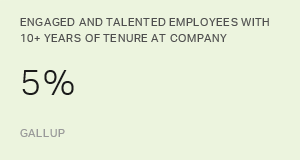Story Highlights
- Companies and employees need continuous, effective communication
- Companies are increasingly using pulse surveys for employee feedback
- When used strategically, pulse surveys are versatile tools
Workplaces are growing increasingly dynamic, as organizational change becomes less of a one-time event and more an everyday reality. The breakneck pace of change and the demand for agility in the workplace has increased expectations for ongoing measurement and more frequent feedback to manage employee performance.
And there is a definite need for continuous but effective communication. Gallup finds that only 27% of workers strongly agree that the feedback they currently receive helps them do their work better. And only 17% strongly agree there's open communication throughout all levels of their company.
Millennials, in particular, are used to open lines of communication for sharing opinions and giving feedback. But in today's highly connected world, all generations of workers are becoming accustomed to constant communication.
To meet this communication challenge, companies seek ways to track real-time employee experiences and gain insights into issues affecting employees' work lives and their organizations' performance. Leaders realize that engaging employees takes more than sending out an annual survey. Instead, it requires a year-long people strategy aimed at clarifying expectations and maximizing performance. To that end, leaders want a way to gather employee feedback throughout the year.
Thus, the rise of pulse surveys.
A pulse survey is an assessment designed to quickly elicit feedback from employees to address work-related topics and employee needs. Pulse surveys range from in-house surveys to assessments administered using a survey platform or by research and consulting companies. This approach can quickly target subsets of an employee population, whether it's a project team, a sample of the employee population or a specific audience affected by a particular company change.
The Value of Pulse Surveys
When used strategically and as complementary tools for larger initiatives, pulse surveys provide valuable data to companies that want the ability to respond quickly to change or increase employee feedback as company initiatives evolve. Many leaders know the value of regularly tracking financial metrics. Pulse surveys also allow them to monitor crucial people metrics. Companies use pulse surveys in many ways, including to:
- Recalibrate: By receiving insights into what employees are thinking about workplace changes -- whether they are reacting to a new rule or policy, a new leader or organizational restructuring -- leaders and managers can use data from pulse surveys to recalibrate actions, resources and priorities to achieve peak performance.
- Diagnose: Pulse surveys can give managers and leaders insight into the effectiveness of strategic initiatives and focus attention on areas of the company that may require more training or support.
- Monitor: Pulse surveys can be an efficient way to monitor a company's mood, employees' workplace experiences or progress toward achieving key performance indicators. They can also be used to monitor the drivers of employee engagement.
- Create momentum: Pulse surveys can be used to spark focused discussion on relevant topics during group meetings. Leaders can also gain timely data to address problems and invite employee involvement in real time.
Pulse Survey Considerations
Pulse surveys and other assessments offer companies valuable insights into what employees are thinking. But surveying employees too often could create excessive amounts of overwhelming or unusable data. To get the most from pulse surveys:
Use pulse surveys as complementary tools. When administering a pulse survey, it's important to understand that it is a feedback mechanism. Pulse surveys can provide additional perspectives on existing organizational problems or strategic initiatives, but they can't solve problems or improve performance on their own. They are best used to support or reinforce other measures and actions.
Be wary of survey fatigue. Pulse surveys can open the door to survey fatigue among employees. When companies conduct pulse surveys often, leaders should carefully consider the types of questions to ask and avoid repeatedly asking similar questions. Employees are more likely to perceive pulse surveys as useful if the questions are interesting and relevant to their work and organizational objectives.
Communicate with employees. Communication with employees about a pulse survey -- especially the survey instructions -- can significantly increase employee survey participation. Though extensive communication campaigns about pulse surveys aren't always necessary, sharing a survey's purpose and the rationale behind it with employees who are asked to participate is best practice.
When leaders determine communication approaches, they should consider their company's culture, environment and industry. For example, some employees understand and expect surveys in the workplace and require less upfront communication than employees who have less experience with workplace studies. Other employees, such as industrial workers, may have limited access to the Internet or email in their day-to-day roles, making additional planning and instruction a necessity for Web-based pulse surveys.
Determine when to conduct pulse surveys. Consider the survey's purpose when determining the best time to conduct it. If the survey is designed to gauge progress on an organization-wide initiative, progress checks can backfire if insufficient time has passed since the initiative was launched. Similarly, if the survey's purpose is to elicit feedback, consider when employees would have enough information to provide useful insights.
Bottom Line
Pulse surveys can be a valuable tool for companies, leaders and managers. When used for intentional and targeted purposes, a pulse survey can serve a vital role in eliciting just-in-time employee feedback on workplace-related topics and organization-wide initiatives. As leaders consider using pulse surveys, they should determine how they will use the feedback and recognize the limitations of pulse surveys. Administering pulse surveys for the wrong reasons or without follow-through can be a useless endeavor.



